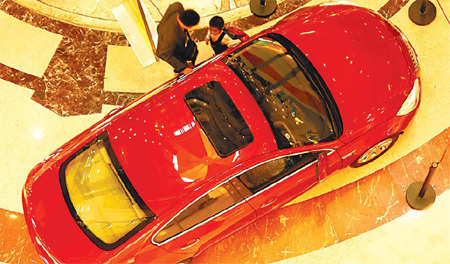
|
BIZCHINA> Top Biz News
 |
|
Auto sales get leg-up from inland regions
By Li Fangfang (China Daily)
Updated: 2009-08-18 08:04
 Li Yuan, a 32-year-old lecturer at Xidian University in Xi'an, Shaanxi province, has been waiting for his Ford Focus sedan for over two months. "It's hard to imagine and accept that I have to wait for such a long time for delivery even after paying for the car. The steady sale of these expensive consumer goods makes me doubt whether there is actually an economic slowdown or not," said Li, a lecturer of economics and philosophy. A salesperson surnamed Wang with Sichuan Huaxing Mingshi Auto Sales Co, the dealer for the Audi brand in Chengdu, was also surprised that the luxury brand's sales this year have far outnumbered that in 2008. "My customers have to wait for at least three months for an Audi A4L car after they order it. It's really unusual, especially in west China," said Wang. Indeed, brisk sales of automobiles in China have come as a counter to worldwide industry stagnation this year. In fact, China has been crowned the world's automobile sales champion for seven consecutive months now. And, unusually, the domestic sales growth has come from developing areas in the west and center, not the usual developed areas in eastern China. According to an auto industry report released by global market research firm Ipsos, car sales growth in west and central China in the first half was 33-percent more than last year's, outpacing the industry average of 22 percent growth. Being the fastest growing markets, west and central China boosted their market share from 24.7 to 27 percent nationally. More impressively, among the 2.73 million license plates issued in China in the first five months, inland provinces and regions, including Shaanxi, Gansu, Ningxia, Heilongjiang, Jiangxi and Sichuan, contributed 35 percent to the total growth of 24 percent so far. The year-on-year growth rate of license plates applications in Shaanxi province even touched 110 percent, compared to a 12-percent drop in Guangdong province. "The negligible impact of the financial crisis in the west and center was a key factor why inland markets grew more robustly than their counterparts in coastal regions, which were seriously hit by the crisis," said Jia Xinguang, chief analyst with the Chinese National Automotive Industry Consulting and Development Corp.
"Moreover, the major transportation vehicles in the rural regions, such as vans, minibuses, and motorcycles, are now being replaced by the smaller engine cars, especially Chinese-brand cars, as the income level in these regions have increased rapidly of late," Sheng pointed out. According to the Ipsos report, in more than half of the regions in west and central China, the growth rates of per capita disposable income were higher than the national average. The Chinese brand vehicles, with relatively lower price tags compared to those manufactured by foreign automakers, had 30.6 percent market share in west and central China, higher than the 26.5 percent average for the domestic market. "From the end of last year, Chinese automakers have stolen a march on their foreign rivals by further expanding their distribution network in inland regions, especially in the third- and fourth-tier cities," said Sheng. Geely's 4S (sales, service, spares and survey) stores in the western and central regions, which accounted for 32 percent of its total network, contributed 34 percent to sales in the first half. And BYD Auto made 36.5 percent of its deals from its 4S stores in west and central China. "Natural demand and higher living standards in inland regions will help the automobile market in west and central China see high speed growth in the near future," said Sheng. "But, from a long-term perspective, with the increase of the vehicle population in inland regions, the increment rate of growth will slow gradually." (For more biz stories, please visit Industries)
|
|||||